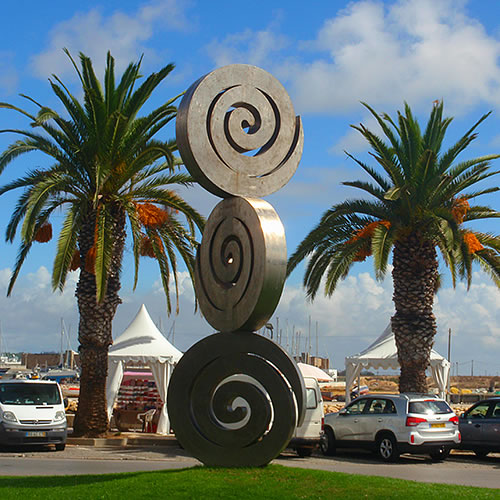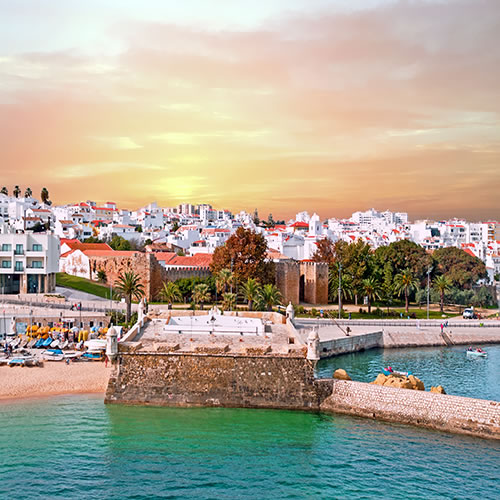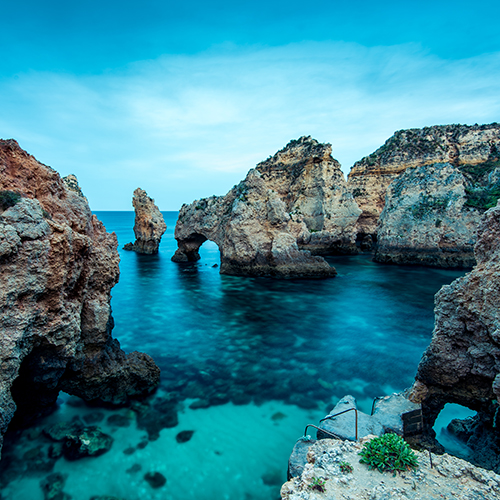Day 1 in Lagos
Welcome to Portugal! Upon arrival, you will go through customs and immigration. Should you opt to purchase a transfer to your hotel; a representative will be waiting for you as you exit immigration. Make your way to Lagos and arrive at your hotel. Check in and do not give in to jet lag! There is so much for you to see and do!
Start sightseeing at the Igreja de Sao Sebastiao. Rebuilt after the devastating 1755 Portuguese earthquake, this site has been home to houses of worship since the 14th century. Get a bite to eat at one of the cafes bordering one of the town`s most popular city squares, the Praca Gil Eanes. While there, catch a glimpse of the 1970s-era Statue of King Sebastian, which was commissioned for the city`s 400th anniversary.
Walk up the Lagos Esplanade and take note of the pedestrian drawbridge spanning Lagos Marina. End the day by posing with some notable Portuguese explorers at the Museu de Cera dos Descobrimentos -- the wax museum dedicated to Portuguese explorers and discoveries.

Day 2 in Lagos
Begin the morning with some souvenir shopping at Praca Gil Eanes. Afterwards, take a leisurely stroll up to the Mercado Municipal and peruse the food and other retail items on sale in the historic two-story building. When you`re walking back toward the `old town` near the Esplanade, stop and view the Monumento dos Descobrimentos Lacobrigenses, a sculpture of three spirals meant to evoke images of the rising and falling tides from the nearby sea.
The first sight to see coming down the Esplanade, set about two blocks to the west and about 1000 feet from Praca Gil Eanes, is the Mercado de Escravos, which functioned in the 17th and 18th centuries as perhaps the very first slave market in Europe. One block away, close to the Jardim da Constituicao, you will find the Statue of Henry the Navigator, the noted Portuguese explorer who conquered faraway lands for a patria (the motherland). Pre-1755 religious architecture can be seen at the Castelo dos Governadores; the largest church in town, the nearby Igreja Paroquial de Santa Maria de Lagos, is an example of religious architecture built after the earthquake of 1755.
You can learn about Lagos and its storied history at the Museu Municipal Doutor Jose Formosinho, in a building that is immediately adjacent to the Igreja de Santo Antonio. End the day by touring the ruins of Lagos Castle, a grand fort that once protected much of the surrounding areas of the Algarve.


Day 3 in Lagos
Lagos is known for its fun in the sun, and today you will have the chance to experience the beaches of your choice. First, start at the Fortaleza da Ponta da Bandeira. Along with Lagos Castle and other fortresses around the region, the waterside fort helped to comprise the first line of defense for the Kingdom of the Algarve (and later the southern portions of the Kingdom of Portugal). Walk along the pier at the nearby Cais da Solaria before sunning yourself at Batata Beach to the east of the fort and pier.
Lagos boasts a number of beautiful beaches, with perhaps the most beautiful, Praia Dona Ana, located just south of Batata Beach. Other beaches located in this area include the picturesque Praia do Camilo, located south of Dona Ana, and Praia do Porto de Mos, with its cool sea breezes, about two and a half miles southwest of town. The grottos around Lagos`s southernmost point, the Ponta da Piedade, are known around the world for their crystal-clear waters and beautifully-colored rock formations. If you have time, make a note to check out the long and winding Meia Praia northeast of Lagos City.


Additional Days in Lagos
If you have an extra day in the area, continue your fun by exploring two notable sights away from the city. For those who like fast cars and racing, the Autodromo Internacional do Algarve north of Lagos hosts all kinds of professional car races, from Le Mans 1000 Hours of Algarve to Formula One test races. Now for those who want more sun and water in their lives, head east from Lagos to Slide & Splash. Built in 1986, it is the oldest water park in Portugal, and sitting on 11 acres of land, it is also the largest. Relax in one of many pools and lazy rivers or take the plunge on such scary water-slide rides as `The Tornado` and `Kamikaze`.
Just east of Lagos is the city of Portimao, which is the Algarve`s second-largest city after Faro. Sitting on the Arade River, Portimao`s current economy is tied very much to the sea. In the 20th century, beach tourism introduced the city of Portimao to the rest of the world. While the skyline is dotted by skyscrapers, Portimao`s long history is evident in such sights as the ruins of the Castle of Alvor, the Fort of Santa Catarina, the Colegio dos Jesuitas, and the Convent of Our Lady of Hope.
If you drive 20 miles southwest of Lagos, you will reach the southwesternmost tip of Portugal and a town called Sagres. Sagres, coming from the Latin meaning sacred, is perhaps best-known for its geographic placement, with a lighthouse and national park occupying much of the land jutting out into the Atlantic Ocean. Also of note in the region of the Fortress of Sagres, in better condition than the castle in interior Lagos, and a church and cemetery called the Nossa Senhora da Graca.


Your Last Day in Lagos
Depart your hotel and head to the airport for your return home. We recommend that you purchase a private transfer; if so, a representative will meet you at the hotel in time to take you to the airport for your flight out.
